木星 月惑星研究会 関西支部 (最新)
ALPO-Japan Latest
Jupiter Image 2000/12/07(UT)
阿久津富夫,畑中明利,林敏夫,池村俊彦,前田和儀,森田光治,河原義則,奥田耕司,永長英夫,
Damian Peach,The Cassini-Huygens mission
T.Akutsu,A.Hatanaka,T.Hayashi,T.Ikemura,K.Maeda,M.Morita,Y.Kawahara,K.Okuda,H.Einaga,D.Peach,Cassini
|
Tomio Akutsu (320mm Newton, Cooled CCD camera Teleris2)
|
|

≪栃木県 阿久津富夫≫
|
Akitoshi Hatanaka (400mm Cassegrain, Video Camera Sony TRV9)
|
|

2000/12/07 12:06:00(UT)
I=7.4d II=261.9d De=3.11d
ビデオ画像より取り出した24枚の画像を合成
40cmカセグレン(自作) f=6000mm
Or25mm使用 コリメート法でビデオに撮影。
ビデオ画像を、キャプチャーし、Stella-Image3で
画像を合成
アンシャープマスクは、PhotoShopを使用。
≪三重県熊野市 畑中明利≫
|
林敏夫 Toshio Hayashi (355mm Schumidt-Cassegrain, Digital still camera Minolta DimageEX1500)
|
|
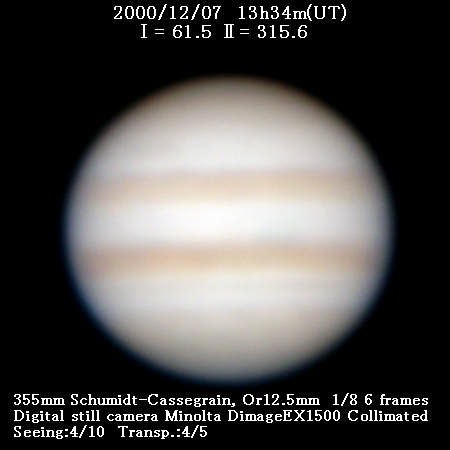
2000/12/07 13h34m(UT) Ⅰ= 61.5 Ⅱ= 315.6
355mm Schumidt-Cassegrain, Or12.5mm 1/8
Digital still camera Minolta DimageEX1500
Collimated DigitalZoom used 7 frames composite
Seeing:4/10 Transp.:4/5
薄雲が流れている中で撮影したが、思ったよりシーング
が悪くないが、デジカメには難しいところ。
≪京都府京都市 林敏夫≫
|
Toshihiko Ikemura (310mm Newton, NEC PICONA)
|
|

2000/12/07 11:04:26(UT)
I=330.5 II=225.4 III=197.7
De= +3.3 E.Dia=48.40"
310mm Newtonian(F5) TeleVue barlow 5x(f/33)
NEC PICONA 1/7sec 2 deg. prism 9 frames composite
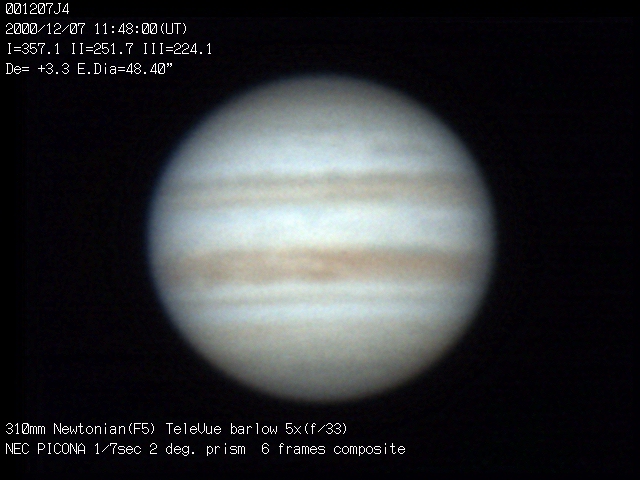
2000/12/07 11:48:00(UT)
I=357.1 II=251.7 III=224.1
De= +3.3 E.Dia=48.40"
310mm Newtonian(F5) TeleVue barlow 5x(f/33)
NEC PICONA 1/7sec 2 deg. prism 6 frames composite

2000/12/07 13:42:42(UT)
I= 67.0 II=321.0 III=293.4
De= +3.3 E.Dia=48.40"
310mm Newtonian(F5) TeleVue barlow 5x(f/40)
NEC PICONA 1/7sec 7 frames composite

2000/12/07 13:44:44(UT)
I= 68.3 II=322.3 III=294.6
De= +3.3 E.Dia=48.40"
310mm Newtonian(F5) TeleVue barlow 5x(f/40)
NEC PICONA 1/7sec 6 frames composite
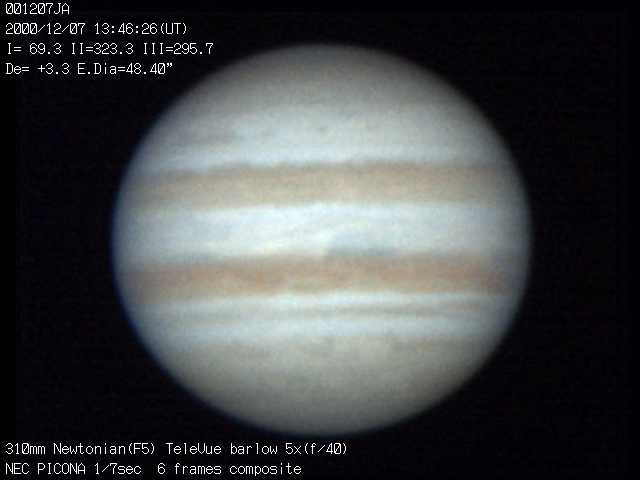
2000/12/07 13:46:26(UT)
I= 69.3 II=323.3 III=295.7
De= +3.3 E.Dia=48.40"
310mm Newtonian(F5) TeleVue barlow 5x(f/40)
NEC PICONA 1/7sec 6 frames composite
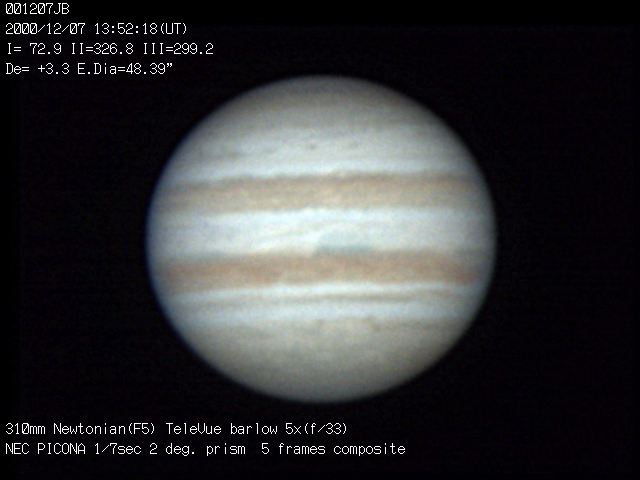
2000/12/07 13:52:18(UT)
I= 72.9 II=326.8 III=299.2
De= +3.3 E.Dia=48.39"
310mm Newtonian(F5) TeleVue barlow 5x(f/33)
NEC PICONA 1/7sec 2 deg. prism 5 frames composite

2000/12/07 13:51:52(UT)
I= 72.6 II=326.6 III=298.9
De= +3.3 E.Dia=48.39"
310mm Newtonian(F5) TeleVue barlow 5x(f/33)
NEC PICONA 1/7sec 2 deg. prism 4 frames composite
[T.Ikemura Nagoya Aichi JAPAN]
≪愛知県名古屋市 池村俊彦≫
|
Kazuyoshi Maeda (350mm Newton, NEC PICONA)
|
|
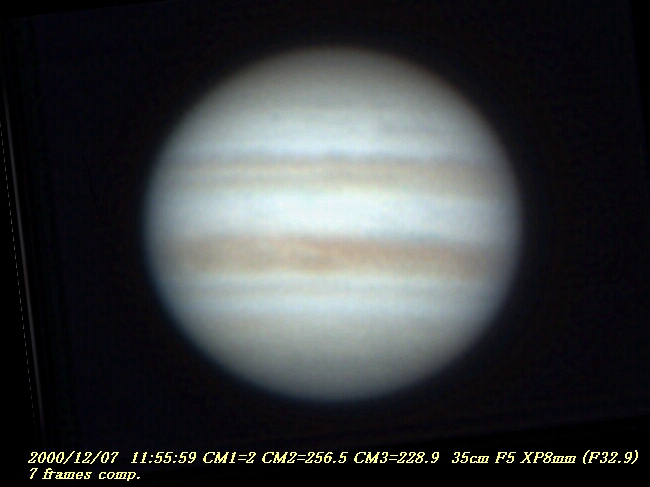
2000/12/07 11:55:59(UT)
ω1= 2.0°ω2=256.5°ω3=228.9°
350mm Newton(F5), XP8mm(f/32.9)
NEC PICONA 1/7sec, 7 frames comp. K.Maeda
De= +3.3゜E.Dia=48.40"
≪京都府 亀岡市 前田和儀≫
|
Mitsuji Morita(203mm Newton,Olympus CAMEDIA c-920ZOOM)
|
|

画像最上段
2000/12/07 12:17:30(UT)
10frames composite
画像二段目
2000/12/07 12:19:30(UT)
ω1=15.4°ω2=269.6°
9frames composite
画像三段目
2000/12/07 13:04(UT)
ω1=42.6°ω2=296.8°
13frames composite
画像最下段
2000/12/07 13:08(UT)
ω1=45.0°ω2=299.3°
8frames composite
共通データ
200mm Newton(F7.6) LA5.8mm
OLYMPUS CAMEDIA C2020zoom
≪滋賀県守山市 森田光治≫
|
河原義則 Yoshinori Kawahara (250mm Cassegrain, Digital still camera NEC PICONA)
|
|
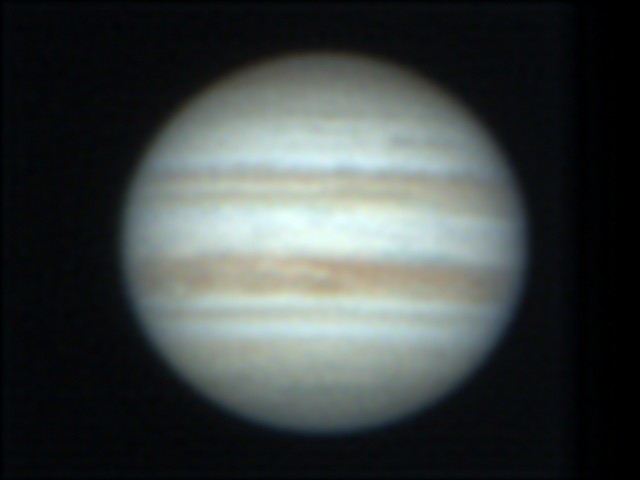
2000/12/07 11:47:36(UT)
I=356.9 II=251.5 III=223.8
De= +3.3 E.Dia=48.40"
250mm カセク゛レン
テレヒ゛ユ-ウハ゛ロ- 3x f/32
Digital camera NEC PICONA 1/7sec
10 frames composite
12月ベストショツトです。
≪愛知県海部郡弥富町 河原義則≫
|
奥田耕司 Koji Okuda (250mm Newton, BITRAN BT-01 Cooled CCD Camera)
|
|
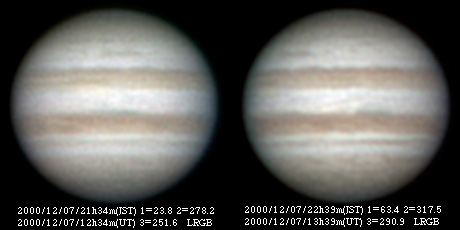
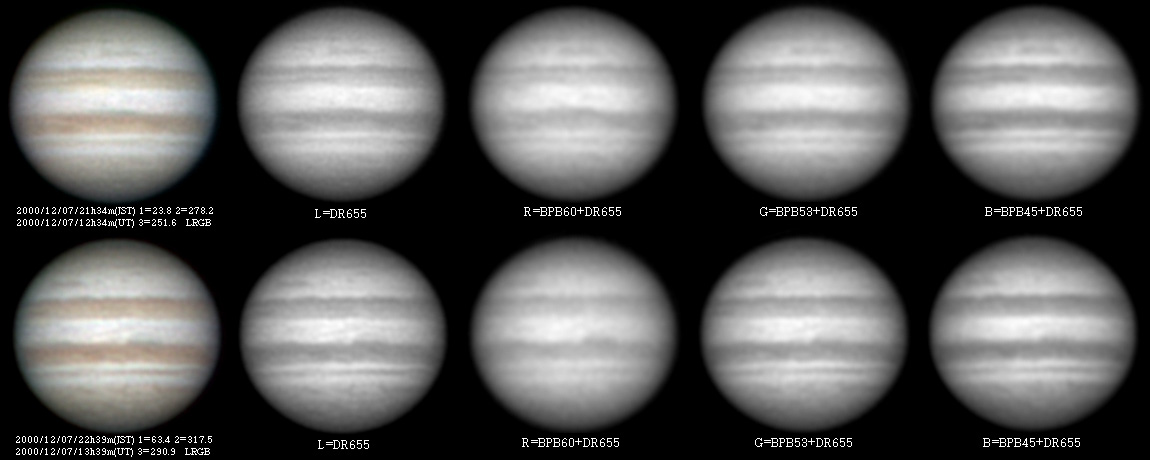 2000/12/07(UT) S=5-6/10 T=10/10
:SSTB以南のベルトが濃い
:白斑BAは眼視ではわずかに明部として感じる
:BA後方のSTBは幅広く濃い
:SEBはCM2=270°まで南北二条の濃いベルト状
:NEBはリフトが目立つ
≪滋賀県信楽町 奥田耕司≫
2000/12/07(UT) S=5-6/10 T=10/10
:SSTB以南のベルトが濃い
:白斑BAは眼視ではわずかに明部として感じる
:BA後方のSTBは幅広く濃い
:SEBはCM2=270°まで南北二条の濃いベルト状
:NEBはリフトが目立つ
≪滋賀県信楽町 奥田耕司≫
|
Hideo Einaga (250mm Newton, Digital Still Camera NEC PICONA)
|
|
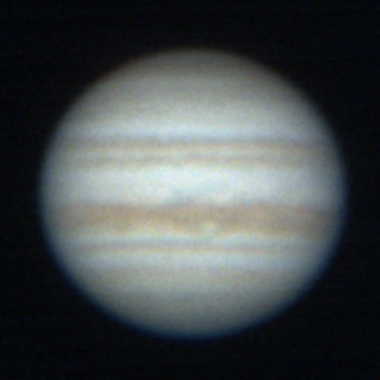
2000/12/07 10:15:38 (UT)
CMI = 300.8, CMII = 195.9, CMIII = 168.2
De = +3.3, E.Dia = 48.40"
3 frames composite
Seeing=3/10,Trans=3/5
25cm+12mm+prism1°+Picona(1/7s)

2000/12/07 11:29:00 (UT)
CMI = 345.5, CMII = 240.2, CMIII = 212.6
De = +3.3, E.Dia = 48.40"
6 frames composite
Seeing=3/10,Trans=3/5
25cm+12mm+prism1°+Picona(1/7s)
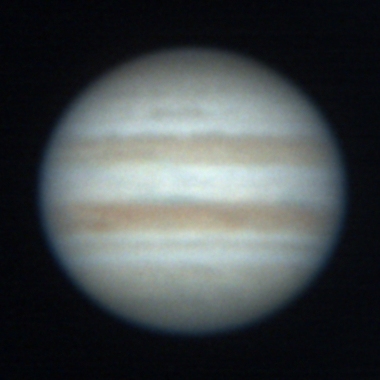
2000/12/07 12:50:23 (UT)
CMI = 35.1, CMII = 289.4, CMIII = 261.8
De = +3.3, E.Dia = 48.40"
7 frames composite
Seeing=3/10,Trans=3/5
25cm+12mm+prism1°+Picona(1/7s)
HIDEO EINAGA ≪兵庫県 加西 永長英夫≫
|
Damian Peach (11" (28 cm) Celestron SCT SBIG ST-5c camera)
|
|
 Winds finally eased a little last night and allowed images .
Still poor conditions unfortunately, but Oval BA's dark rim still seems faded.
[Rochester, Kent, UK.]
≪≪ダミアン-ピーチ イギリス カナリア諸島≫≫
Winds finally eased a little last night and allowed images .
Still poor conditions unfortunately, but Oval BA's dark rim still seems faded.
[Rochester, Kent, UK.]
≪≪ダミアン-ピーチ イギリス カナリア諸島≫≫
|
The Cassini-Huygens mission
|
South up South up  Original image tif 2324kB Original image tif 2324kB
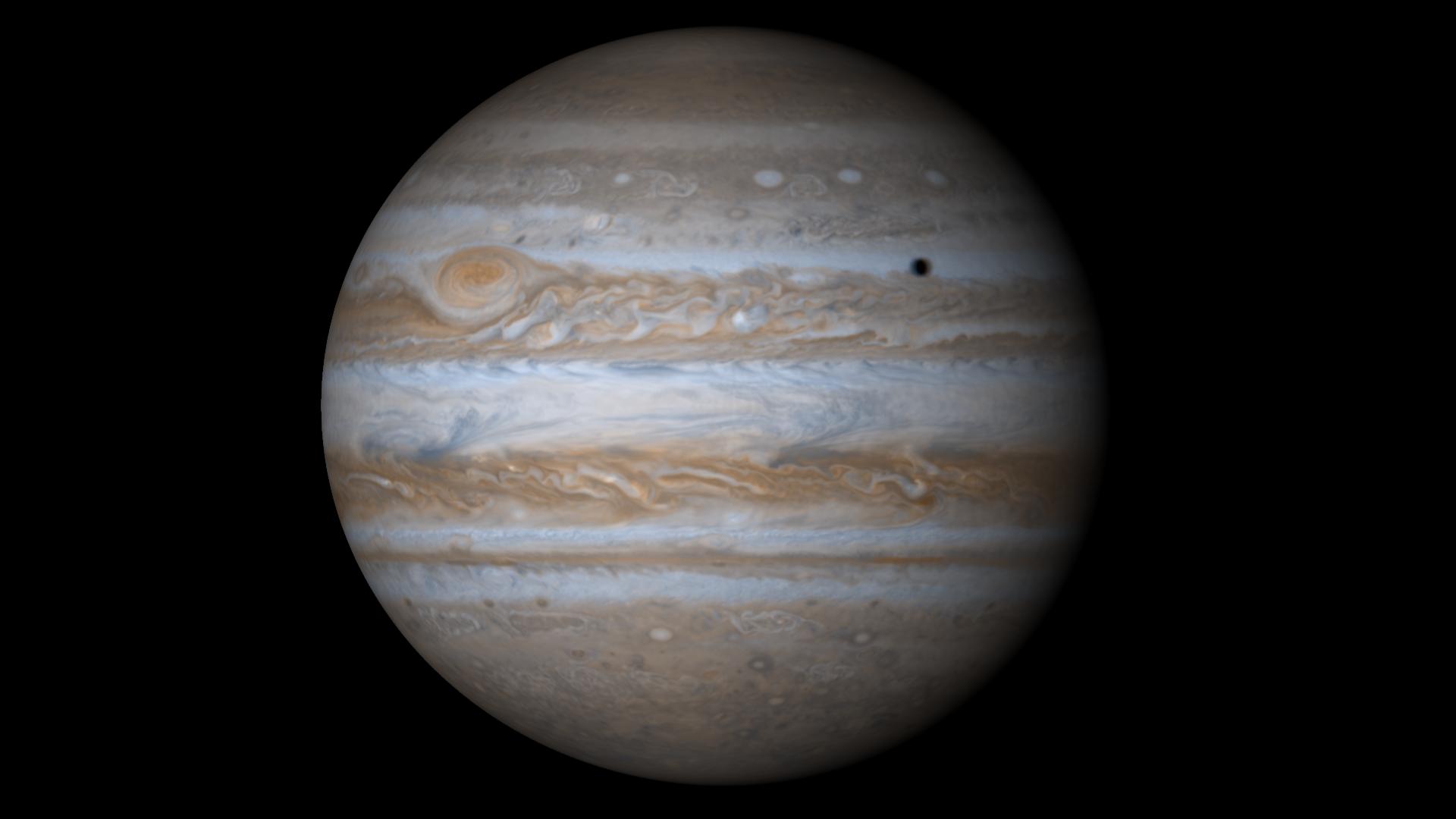
This true-color simulated view of Jupiter is composed of 4 images taken by NASA's Cassini spacecraft on December 7, 2000. To illustrate what Jupiter would have looked like if the cameras had a field-of-view large enough to capture the entire planet, the cylindrical map was projected onto a globe. The resolution is about 144 kilometers (89 miles) per pixel.Jupiter's moon Europa is casting the shadow on the planet.
Cassini is a cooperative mission of NASA, the European Space Agency and the Italian Space Agency. JPL, a division of the California Institute of Technology in Pasadena, manages Cassini for NASA's Office of Space Science, Washington, D.C.
Image Credit:
NASA/JPL/University of Arizona
South up South up  Original image tif 711kB Original image tif 711kB

One moment in an ancient, orbital dance is caught in this color picture taken by NASA's Cassini spacecraft on Dec. 7, 2000, just as two of Jupiter's four major moons, Europa and Callisto, were nearly perfectly aligned with each other and the center of the planet.
The distances are deceiving. Europa, seen against Jupiter, is 600,000 kilometers (370,000 miles) above the planet's cloud tops. Callisto, at lower left, is nearly three times that distance from the cloud tops. Europa is a bit smaller than Earth's Moon and has one of the brightest surfaces in the solar system. Callisto is 50 percent bigger -- roughly the size of Saturn's largest satellite, Titan -- and three times darker than Europa. Its brightness had to be enhanced in this picture, relative Europa's and Jupiter's, in order for Callisto to be seen in this image.
Europa and Callisto have had very different geologic histories but share some surprising similarities, such as surfaces rich in ice. Callisto has apparently not undergone major internal compositional stratification, but Europa's interior has differentiated into a rocky core and an outer layer of nearly pure ice. Callisto's ancient surface is completely covered by large impact craters: The brightest features seen on Callisto in this image were discovered by the Voyager spacecraft in 1979 to be bright craters, like those on our Moon. In contrast, Europa's young surface is covered by a wild tapestry of ridges, chaotic terrain and only a handful of large craters.
Recent data from the magnetometer carried by the Galileo spacecraft, which has been in orbit around Jupiter since 1995, indicate the presence of conducting fluid, most likely salty water, inside both worlds.
Scientists are eager to discover whether the surface of Saturn's Titan resembles that of Callisto or Europa, or whether it is entirely different when Cassini finally reaches its destination in 2004.
Cassini is a cooperative project of NASA, the European Space Agency and the Italian Space Agency. The Jet Propulsion Laboratory, a division of the California Institute of Technology in Pasadena, manages the Cassini mission for NASA's Office of Space Science, Washington, D.C.
Image Credit:
NASA/JPL/University of Arizona
[NASA/JPL/Space Science Institute]
 ALPO-Japan Latest ALPO-Japan Latest

 Jupiter2000 Apparition Jupiter2000 Apparition
|
 2000/12/07(UT) S=5-6/10 T=10/10
:SSTB以南のベルトが濃い
:白斑BAは眼視ではわずかに明部として感じる
:BA後方のSTBは幅広く濃い
:SEBはCM2=270°まで南北二条の濃いベルト状
:NEBはリフトが目立つ
≪滋賀県信楽町 奥田耕司≫
2000/12/07(UT) S=5-6/10 T=10/10
:SSTB以南のベルトが濃い
:白斑BAは眼視ではわずかに明部として感じる
:BA後方のSTBは幅広く濃い
:SEBはCM2=270°まで南北二条の濃いベルト状
:NEBはリフトが目立つ
≪滋賀県信楽町 奥田耕司≫













2000/12/07(UT) S=5-6/10 T=10/10 :SSTB以南のベルトが濃い :白斑BAは眼視ではわずかに明部として感じる :BA後方のSTBは幅広く濃い :SEBはCM2=270°まで南北二条の濃いベルト状 :NEBはリフトが目立つ ≪滋賀県信楽町 奥田耕司≫



Winds finally eased a little last night and allowed images . Still poor conditions unfortunately, but Oval BA's dark rim still seems faded. [Rochester, Kent, UK.] ≪≪ダミアン-ピーチ イギリス カナリア諸島≫≫
 Original image tif 2324kB
Original image tif 2324kB 
 Original image tif 711kB
Original image tif 711kB 
 ALPO-Japan Latest
ALPO-Japan Latest

 Jupiter2000 Apparition
Jupiter2000 Apparition